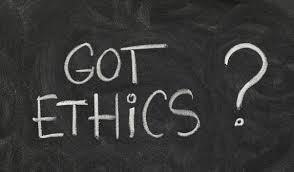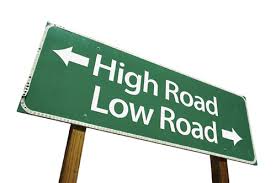Wall Street and Ethics
 I have to confess that there is a part of me that was skeptical about a new survey released last week finding that banks and other financial institutions have not embraced a culture of integrity. (Survey Here). Indeed, the survey found that numerous individuals continue to operate with the idea that illegal or unethical behavior is a necessary part of succeeding in the financial markets.
I have to confess that there is a part of me that was skeptical about a new survey released last week finding that banks and other financial institutions have not embraced a culture of integrity. (Survey Here). Indeed, the survey found that numerous individuals continue to operate with the idea that illegal or unethical behavior is a necessary part of succeeding in the financial markets.
Are you kidding?
Does this mean that the multi-million dollar penalties and fines paid by bank after bank has had no impact?
Does this validate what many have been arguing that the only way to deter illegal conduct is to prosecute and punish individual lawbreakers?
I do not know the answer to these questions but the survey should raise everyone’s eyebrows.
Lets’ look at some of the key findings:
- 47 percent of respondents in the financial industry stated it was “likely” that competitors have engaged in illegal or unethical conduct to gain an advantage in the market (an increase of 8 percent from 2012 survey results);
- 34 percent of those earning $500,000 or more annually have witnessed or have first-hand knowledge of wrongdoing in the workplace;
- 23 percent believe it is likely that fellow employees have engaged in illegal or unethical conduct to gain an advantage, nearly double the 12 percent reported in 2012; and
- 25 percent would likely use non-public information to make a guaranteed $10 million if there was no chance of getting arrested for inside trading.
These numbers befuddle me. I really do not understand how this could be true.
JPMorgan Chase has devoted significant resources and effort to improve its corporate ethics in response to a string of controversies, including the 2012 London Whale incident. The survey suggests that while important statements and policies are being adopted, the culture is not becoming embedded. It means that more has to be done to turn this culture around.
At JPMorgan Chase, team leaders were tasked with spreading the word on compliance and ethics. This was part of the culture shock. The company also rearticulated and recommitted the firm to a set of 20 business principles that include important values and integrity. The revised principles were published and distributed to every employee, and are embedded in recruiting, training and performance management. The company also refreshed its code of conduct.
Bank of America and Wells Fargo are following similar paths to refresh and promote its values and commitment to integrity.
Bank regulators are also pushing banks to improve their culture. The recent FinCEN advisory noted that “a poor compliance culture” was at the root of many recent enforcement actions. Banks have followed through on their commitment to elevate the CCO to the C-Suite and to have the CCO report to the CEO or COO. Banks also have sought out more independent directors to serve on their boards, hoping that this will have an important impact on bank culture.
There are countervailing considerations to the increased focus on culture. Financial institutions are facing a greater volume and complexity of risks. Enterprise risks are fast outpacing whatever gains are being made on corporate culture. Fewer companies are devoting time to risk management when reviewing strategic plans – that could be a trend leading to disaster. If financial companies ignore serious operational risks, we are walking down a familiar path that could lead to disastrous economic consequences.
 Banks and other financial institutions have to build a better ERM model that focuses on large overall risks, as well as operational risks. The key to an effective ERM program is not to divide these inquiries into separate silos but to identify and measure them, and then ensure that there are proper procedures to elevate and focus management on risks within each category.
Banks and other financial institutions have to build a better ERM model that focuses on large overall risks, as well as operational risks. The key to an effective ERM program is not to divide these inquiries into separate silos but to identify and measure them, and then ensure that there are proper procedures to elevate and focus management on risks within each category.
The key for banks and financial institutions is to marry risk and strategy so that the outcome takes everything into consideration. Culture is an important part of this analysis because it can only be embedded in a company when risk and strategy provide a prism for viewing operations.














